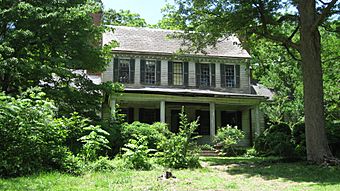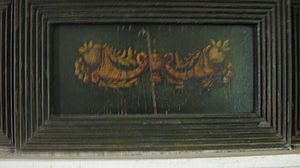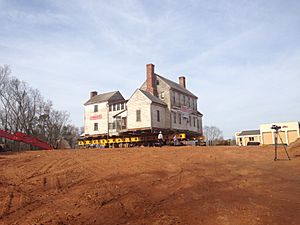Crabtree Jones House facts for kids
Quick facts for kids |
|
|
Nathaniel Jones Jr. House
|
|

The Jones House before its move, 2013
|
|
| Location | 3108 Hillmer Drive, Raleigh, North Carolina |
|---|---|
| Area | 5 acres (2.0 ha) |
| Built | 1795 |
| Architectural style | Federal, Georgian |
| NRHP reference No. | 73001376 |
| Added to NRHP | June 4, 1973 |
The Crabtree Jones House, also known as the Nathaniel Jones Jr. House, is a historic home in Raleigh, North Carolina. It was built around 1808-1811 by Nathaniel Jones. This house is one of the few large plantation homes left in Wake County. It is also one of the oldest private homes in Raleigh.
The house has been changed and added to over the years. It is most famous for its beautiful Federal-style front. The Jones family owned the house for over 150 years. In recent times, the house started to fall apart. In 2012, developers bought the land where the house stood. A group called Preservation North Carolina then bought the house. They moved it to a new neighborhood nearby. The Crabtree Jones House has seen many historical events. It also helped shape how the Raleigh community grew.
Contents
History of the Crabtree Jones House
How the Jones Family Got the Land
The land where the Crabtree Jones House stands has been owned by the Jones family for over 200 years. The family first got some land in the 1740s. This was a special gift from the Earl of Granville to Francis Jones. An earlier Jones house was thought to be built near Crabtree Creek. But it was likely destroyed by floods from the creek.
Because of the floods, a new home was needed further away. The Crabtree Jones House was built to solve this problem. It sits on a tall hill, about 40 feet higher than the land around it. It is also over 100 feet above the creek. From the house, you can see Crabtree Creek about 900 yards away.
Building the House and Its First Owner
The house was finished around 1808. At that time, Raleigh was a new city, formed in 1792. The Crabtree Jones House was one of only a few buildings nearby. Nathaniel Jones, an early Raleigh resident, built the home. He was a planter, meaning he owned a large farm. He was also a politician.
Nathaniel Jones was very active in local government. He served as the county sheriff and a state congressman. He was also one of the first people to own land in Raleigh. Nathaniel Jones became known as Crabtree Jones. This helped tell him apart from his father, Nathaniel Jones Sr. His nickname came from the Crabtree Creek area where his house was built.
Life Before the Civil War
Crabtree Jones passed the house and a large farm to his son, Kimbrough Jones. Kimbrough made the farm much bigger and more valuable. In 1850, the family's property was worth about $18,619. By 1860, it was worth $50,000. It is believed that the main crop grown on the farm was tobacco.
Like his father, Kimbrough was involved in state politics. He served several terms in the North Carolina general assembly. When the American Civil War began, Kimbrough was an old man. He was 76 years old in 1860.
During the war, both sides used the Jones's land. Camp Crabtree, a large training camp for Confederate soldiers, was located there. The house was badly damaged when General Sherman's troops came through. They destroyed or stole most of the furniture and personal items. Kimbrough wrote in 1865 that "everything in the house and out of doors" was destroyed. Kimbrough Jones died in 1866, a year after the war ended. He left the house to his son, Kimbrough Jones Jr.
After the Civil War
The Jones family remained an active part of the community for many years. Some of Kimbrough Jr.'s sons joined the army after World War I. They did this to get money for their college education. Letters show that the sons did not enjoy army life. They also show that the Jones family had important political connections.
A US senator and the State Treasurer even wrote letters to the army. They asked for Peter Jones, one of the sons, to be sent home to help on the farm. One of Kimbrough Jr.'s sons, BK Jones, went to NC A&M (now NC State University). The Jones children went to Millbrook High School in the 1930s.
The house continued to be a working farm for the first half of the 1900s. Cotton was a main crop, but the farm grew many other things too. The Crabtree Jones House was even on the cover of The Progressive Farmer magazine in 1934. Religion was also important to the Jones family. Kimbrough Jones Sr. wrote in 1848 that the worst thing about a place was "that there is little religion here." In the 20th century, the family was involved with Millbrook United Methodist Church. The Jones family owned the house and land until they sold it to a developer in 1973.
Saving the House
By the late 1900s, the Crabtree Jones House was in bad shape. The land around the house was being developed. People started trying to save the home. In 1969, the city of Raleigh named it a historic site. In 1973, it was added to the National Register of Historic Places.
The new owner, Charles Gaddy, promised to protect the house. This saved it from being torn down for a while. But it still needed a lot of repair. Several groups tried to buy the house to fix it up. In 1974, it was estimated that repairs would cost $40,000 to $45,000. By the early 2000s, only the house and one acre of land were left. The cost to fix it up was then estimated at $500,000.
House Design and Features
The Crabtree Jones House has an interesting architectural history. Scientists studied the wood in 2014. They found that the front of the house was built in 1808-09. The stairwell was built in 1811. The wooden floor beams in the house have some damage from termites over the centuries.
The main part of the house is a great example of early Federal architecture. This section has two stories and is five bays wide. A "bay" is a section of the house, usually with a window or door. On each side, there is a one-story extension that is one bay wide.
Inside, the house has a traditional hall and parlor house layout. The front door, a single wooden door with six panels, opens into the main dining room. The original stairs to the second floor were removed. Now, the main stairs are in the hallway of the first addition. The house is thought to have had no porch at first. But it had decorated porches at different times. One fancy Italianate porch was added around the mid-1800s. A simpler one was added around the early 1900s. This second porch was removed when the house was moved in 2014.
The house has two additions. One was likely built in the early 1800s, and the second around the mid-1800s. These additions have special features. They include Greek revival moldings and an enclosed slanted porch on the second story. The house has three brick chimneys. Two are in the main part, and one is in the back extension. The mantels (shelves above fireplaces) in the front of the house are special. They are painted with detailed scenes of nature. The door hinges are old-fashioned H and L bolt style. Screen doors and windows were added in some places starting in 1925. The outside of the house is covered with wood weatherboards. It is currently painted white.
Before it was moved, the Crabtree Jones House had a large English basement. When Preservation North Carolina looked closely, they found that the basement had been used as a family trash dump for many years. They found many old items, like broken glass and pottery. These items were saved. The English Basement was taken down to make room for new apartments. Archeologists also dug at the new site where the house was moved, but they didn't find anything important there.
Moving the House
In 2005, Charles Gaddy, the owner, passed away. In 2009, the land was sold to another development company. The Crabtree Jones House was planned to be torn down in 2012. The land, including where the house sat, was going to become apartment buildings. Much of the forest on the remaining one-acre property was cut down.
Luckily, a group called Preservation North Carolina stepped in. They worked with the developer and the local community. They were able to move the house off its hill. It was moved to a nearby neighborhood from the 1960s. The Jones family cemetery is also in this neighborhood.
Moving the house was a big challenge. The house weighed 200 tons. It had to be moved down a very steep hill. This was done using special computer-controlled hydraulic pumps. These pumps kept the house level as it moved. The move cost $632,000. This included putting the house on the moving equipment, transporting it, and buying and tearing down a 1960s house at the new site. The Crabtree Jones House was successfully moved on February 4, 2014.
Impact on the Community
In April 2014, the Crabtree Jones House was still in the news. Its move brought back a discussion about saving historic buildings. This was especially true in Raleigh's Oakwood Historic District. This area has many different styles of homes, from Victorian houses to 1920s bungalows.
However, in recent years, people in Oakwood have not wanted new houses built. They also didn't want additions to existing homes. One example was a new house with a modernist design. Some neighbors supported it, but many others did not. The debate even went to court.
The Crabtree Jones House has been used as an example by those who support the modern house. The Jones house itself has many different architectural styles. It was renovated many times in the 1800s. Groups like Preservation North Carolina argue that having different styles adds to Oakwood's history. They believe it makes the area more unique.
The preservation of the Crabtree Jones House also brought the community together. It put historic preservation back in the spotlight. Its unique features have started new discussions about saving old buildings. It also sparked talks about building modern houses in historic areas. The house has been affected by almost every major event in North Carolina since it was built. The Jones family helped the local community through their service and farming. In these ways, the house has been an important part of Raleigh's history.
Images for kids








